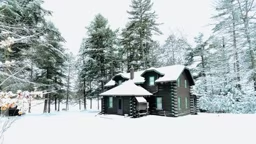
Spend a night in a log home and you’ll know: It’s one snug piece of architecture. Indeed, sealants — material applied between log courses and around openings such as windows and doors — are your protectors against weather. Choosing a sealant that’s right for both your log system and your climate is a vital component to creating an energy efficient log home.
Like any home, log homes settle. In a stick-framed home, that settlement occurs behind drywall, so unless the settlement causes nail pops or even cracks in the wall’s surface, it’s not noticeable, nor does it cause structural issues.
Likewise, log home designers have engineered their wall systems to allow for movement while maintaining a tight seal. The greatest amount of movement or settlement in your walls will occur during the first three to five years after construction, depending on your climate and your wall system. After this period, movement slows down and won’t be noticeable. A successful sealant system should accommodate both the amount of movement in the first few years as well as slower changes that occur over time.
Certain locations, particularly around doors and windows or at corners, are more prone to sealant breaches caused by settlement. Seldom do sealants fail in more than one or two locations, unless the home wasn’t built to the producer’s specifications.
Sealants vary in their ease of application, cost, durability and aesthetic appeal. Log home producers typically recommend one or more sealant product Lines to match their log profile or building System. Here’s a rundown of the sealant products you might hear about when planning your home:
• Caulk. Fills joints and spaces between logs. Caulk comes in tubes or pails and is applied with a caulk gun in a narrow strip or “bead” that dries to a tough elastic coating. It’s applied in a color that Matches the wood tone so that it’s not prominent when viewed from a distance.
• Chinking. A thick, usually white, material used between rows of logs. Most often used in log systems where logs don’t directly contact the course below, but are separated by a space of about 1 inch or more. Modern synthetic chinking, manufactured to look like traditional chinking, is similar to caulk but with greater density and overall durability.
• Splines. A rigid wood, plastic or metal piece used to seal joints. On log homes, splines are sometimes used in the Joint where adjacent logs butt together. They’re also used in some milled and handcrafted systems to align, hold and seal window and door bucks to logs.
• Foam gaskets. Compressible foam material, usually water-resistant, used between logs and other building Components to prevent air and water infiltration. Many tongue-and-groove log systems use foam gaskets to seal the joints between adjacent rows of logs.
To learn more about energy efficiency, download the rest of this comprehensive article to better design for energy performance.
Fill out the form below to download, "Solving the Energy Riddle."
By submitting this form, I acknowledge and agree to Active Interest Media's (AIM) Terms of Service and to AIM's use of my contact information to communicate with me about AIM or its third-party partners' products, services, events and research opportunities. AIM's use of the information I provide will be consistent with the AIM Privacy Policy. In addition, I understand that my personal information will be shared with any sponsor(s) of the resource, so they can contact me directly about their products or services. Please refer to the privacy policies of such sponsor(s) for more details on how your information will be used by them.







_11868_2023-04-27_10-18-256x288.avif)




